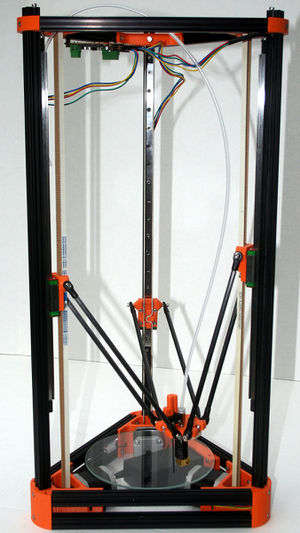Mechanical Rigidity/Original Kossel
Kossel Delta Printers
The Kossel is an innovative design that is unfortunately completely lacking in rigidity:
Essentially its frame is a toblerone, however as can be seen each rectangular face has absolutely no bracing whatsoever. Twisting is therefore extremely easy to do about the Z-axis, and there will also be significant shearing in both X and Y. An original Kossel Delta printer should, for this reason alone, be avoided.
Properly fixing a Kossel's toblerone frame, by adding diagonal bracing from corner-to-corner across all three of the rectangular faces, would unfortunately impinge significantly onto the build area. However adding picture-frame-style panels with a border of at least 40mm and a material thickness of at least 6mm in acrylic (similar to the Ultimaker-2 front panel) would do the trick. Due to the length of the uprights, the number of attachment points would however need to be increased.
The typical use of plastic parts for the corners in Kossel designs is also a major factor in the lack of rigidity. However efforts to replace these with metal, or to brace the twin base with external panels, really does not help because the uprights are so long in a Delta printer that the flexibility of the uprights themselves becomes significant.
Add to that the fact that Delta printers require extreme micro-millimetre-accurate lengths of rods and require extremely complex calibration and they're just not worth the hassle.
